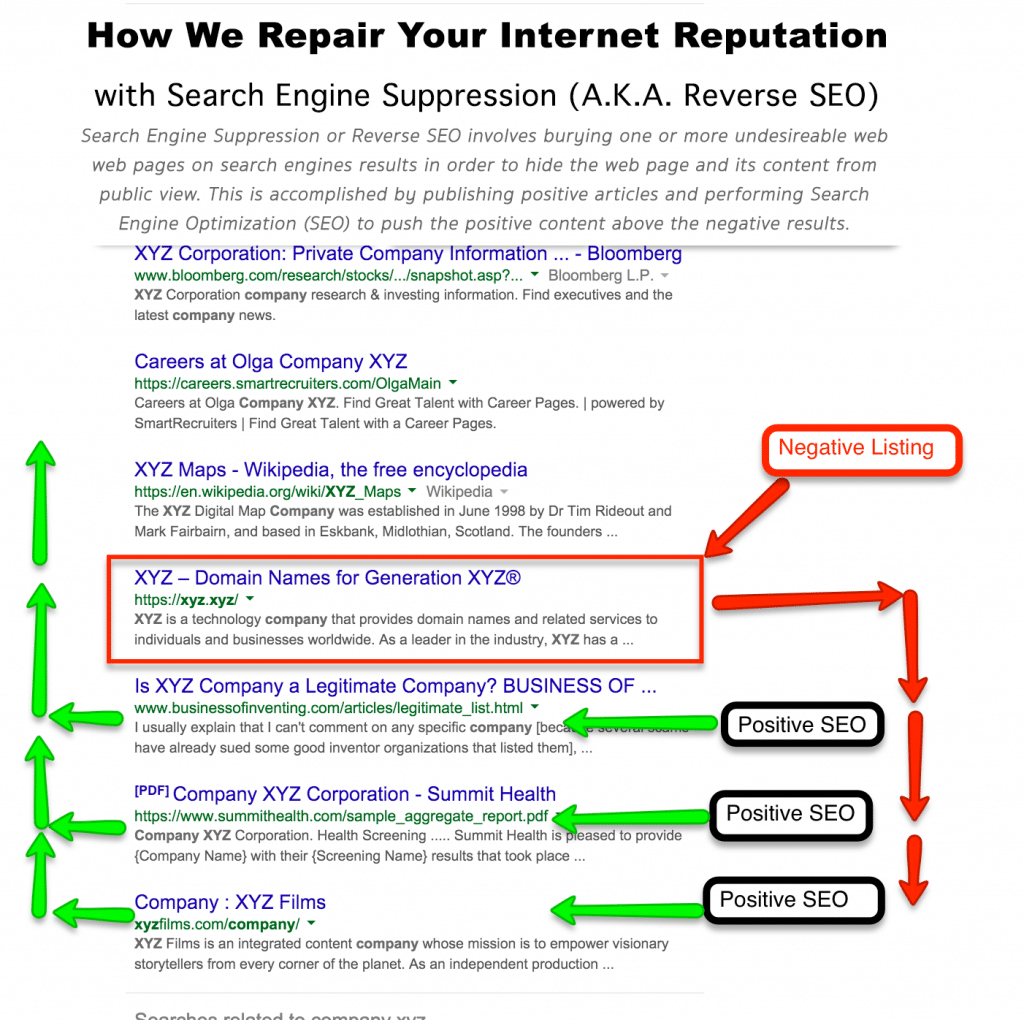Table Of Content
How to Repair Internet Reputation Damage with Reverse SEO in 2022
SEO, or search engine optimization, has become a stronghold of digital marketing. What used to be about simple keywords is now a full-fledged guidebook of how to market your business online. It's so comprehensive, in fact, that many people have entire careers centered on SEO.
It’s how you get your brand to the top of search results and get consumers to your website. But sometimes, this can backfire. The internet values user reviews and honest opinions. When customers publish negative reviews or content about your business, it appears at the top of search results, too, right alongside your business website. Thankfully, Reverse SEO is how you can rectify that situation, allowing one to take control of his or her name or company name on search engine results, and by doing so, allows the individual to effectively resolve their web presence problem.
What is Reverse SEO?
While traditional SEO seeks to bring a page to the top of search results, reverse SEO does the opposite. It drops a page's rank and makes it hard to find. This is useful for "burying" bad reviews and other negative information. There are two main pillars of reverse SEO:
1. Actively removing negative web content
Start by speaking with the person who created the content. In some cases, you can pay the creator or seek legal action. In most cases, however, it's not possible to remove it. This is common for true complaints, such as bad reviews from former customers.
2. Suppressing unwanted search results that you can't get removed
In cases where negative content cannot be removed, Reverse SEO strategies will suppress or bury negative search results on SERPs.
By creating a wealth of positive content about the product, service, or business and promoting this content with regular Search Engine Optimization techniques the negative pieces will move further down the results page.

How Does Search Engine Suppression via Reverse SEO work for Online Reputation Repair?
Reverse SEO can help businesses with bad reputations wipe the slate clean and start over. Negative content is severely detrimental to your brand, be it your personal brand or that of your company, and you can't always control when it's going to emerge on Google Search, Bing or some other web search or social site.
You can't always know when a customer is going to be unsatisfied with your product or service. You can't know if they call to complain and catch a representative on a bad day. And, you can't help it if the customer is still unhappy, regardless of your best efforts. Sometimes, bad content is simply unavoidable.
Unfortunately, this type of content is given a lot of credence. As many business owners know, one bad review gets a lot more traction than a good one. Reverse SEO uses a series of tactics to make sure bad content is harder to find while bringing quality content to the forefront. ORM (online reputation management) strategists use reverse SEO as one of their tools to grow and strengthen your brand's reputation.
4 Effective Reverse SEO Strategies for Online Reputation Repair and Search Engine Reputation Management (SERM)
As with traditional SEO, reverse SEO has a multitude of best practices. Using these practices, an ORM strategist will clean up your brand's "canvas" and make a foundation for building a new, better reputation. Some tactics may include:
- Starting a blog and publishing engaging, helpful content on a regular basis. This works on two levels. First, publishing regular pieces will increase the quantity of positive content associated with your brand. Second, using traditional SEO strategies in your new content will increase the quality of your reputation.
- Publishing other types of content that position your company as an industry expert. White papers, articles, and industry advice forums (like Quora) are all great places to do this. By publishing content here, and linking to your website, you bury negative reviews while demonstrating your industry expertise.
- Being active on social media, or starting a new social media channel. Google search results show your various social media identities, whether it's your latest Facebook post, Tweet, or Instagram photo. Again, the more active you are, the more reputable you'll become.
- Finding ways to remove negative content if possible. An ORM strategist may suggest reaching out to bloggers or reviewers on social media and asking them to remove their posts. In some cases, you may be able to take legal action, but this isn't common.
Although it can be discouraging to read negative content about your business, it doesn't have to be the end of your brand. Many times, this type of content is unwarranted and not necessarily your fault.
All businesses, no matter how strong their customer relationships are, will experience a bad review or negative internet post at some point. Just remember, the important thing is how you react and what you plan to do about it. Put your emotions aside and create a plan to resolve the situation and get rid of those unwanted search results.
Sources
- http://www.sitepronews.com/2011/10/24/four-tactics-to-use-reverse-seo-to-mitigate-a-corporate-crisis/
- https://moz.com/beginners-guide-to-seo
- https://seo-hacker.com/search-engine-reputation-management-reverse-seo/



